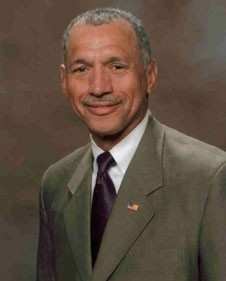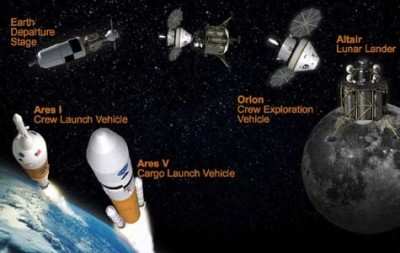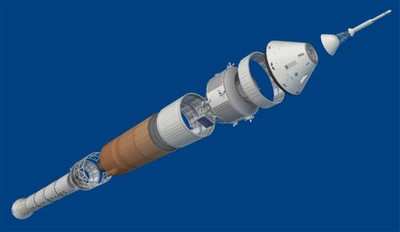President's Budget Request Jeopardizes Return To The Moon
 NASA Administrator Charlie Bolden
held a news conference Monday to outline the agency's budget for
fiscal year 2011, in which the President zeroed out the
Constellation and Ares programs which had been intended to return
men to the moon.
NASA Administrator Charlie Bolden
held a news conference Monday to outline the agency's budget for
fiscal year 2011, in which the President zeroed out the
Constellation and Ares programs which had been intended to return
men to the moon.
"President Obama today has given us a bold challenge -- to
become an engine of innovation, and the catalyst for an ambitious
new space program that includes and inspires people around the
world," Bolden said in his opening remarks. "With this budget
and the steps it lays out, the United States and its partners in
other nations, in industry, and in academia will pursue a more
sustainable and affordable approach to spaceflight through the
development of transformative technologies and systems."
"We will blaze a new trail of discovery and development. We will
facilitate the growth of new commercial industries. And we will
expand our understanding of the Earth, our solar system, and the
universe beyond. To accomplish these objectives, the president has
increased NASA's budget over the next five years by 6 billion
dollars, an extraordinary show of support in these tough budgetary
times."
Bolden (below, right) focused primarily on the positive
aspects of the budget. "First, with this budget we are
demonstrating our commitment to extend the life of the
International Space Station, likely to 2020 or beyond," he said.
"This will keep a commitment to our international partners and
develop the full potential of this amazing orbiting laboratory
where humans regularly do things we have never done before. NASA is
on track to fly out the remaining Space Shuttle manifest of five
flights, safely, and by the end of this calendar year. Within the
week we'll be launching Endeavour to the International Space
Station to deliver the Tranquility node, and a seven-windowed
cupola that will be a control room for robotics and a new window on
the world for the ISS astronauts."
 "Next, the president has laid out a
dynamic plan for NASA to invest in critical and transformative
technologies. These will enable our path beyond low Earth orbit
through development of new launch and space transportation
technologies, nimble construction capabilities on orbit, and new
operations capabilities. Imagine trips to Mars that take weeks
instead of nearly a year; people fanning out across the inner solar
system, exploring the Moon, asteroids and Mars nearly
simultaneously in a steady stream of “firsts;” and
imagine all of this being done collaboratively with nations around
the world. That is what the President’s plan for NASA will
enable, once we develop the new capabilities to make it a reality.
NASA will accelerate and enhance its support for the commercial
spaceflight industry to make travel to low Earth orbit and beyond
more accessible and more affordable. Imagine enabling hundreds,
even thousands of people to visit or live in low Earth orbit, while
NASA firmly focuses its gaze on the cosmichorizon beyond
Earth."
"Next, the president has laid out a
dynamic plan for NASA to invest in critical and transformative
technologies. These will enable our path beyond low Earth orbit
through development of new launch and space transportation
technologies, nimble construction capabilities on orbit, and new
operations capabilities. Imagine trips to Mars that take weeks
instead of nearly a year; people fanning out across the inner solar
system, exploring the Moon, asteroids and Mars nearly
simultaneously in a steady stream of “firsts;” and
imagine all of this being done collaboratively with nations around
the world. That is what the President’s plan for NASA will
enable, once we develop the new capabilities to make it a reality.
NASA will accelerate and enhance its support for the commercial
spaceflight industry to make travel to low Earth orbit and beyond
more accessible and more affordable. Imagine enabling hundreds,
even thousands of people to visit or live in low Earth orbit, while
NASA firmly focuses its gaze on the cosmichorizon beyond
Earth."
Bolden said the President is also deeply committed to NASA's
vital programs to understand Earth, and has given the agency the
means to increase its efforts to learn more about Earth's
climate.
Bolden said the President's decision to scrap the Constellation
Program was based on the report of the Augustine Commission. "They
found that Constellation key milestones were slipping, and
that the program would not get us back to the moon in any
reasonable time or within any affordable cost. Far more funding was
needed to make our current approach work. The Augustine Committee
estimated that the heavy lift rocket for getting to the moon would
not be available until 2028 or 2030, and even then they found
“there are insufficient funds to develop the lunar lander and
lunar surface systems until well into the 2030s, if ever."
"And as we focused so much of our effort and funding on just
getting to the Moon, we were neglecting investments in the key
technologies that would be required to go beyond. So this budget
cancels the Constellation Program, including the Ares I and V
rockets and the Orion crew exploration vehicle. NASA intends to
work with the Congress to make this transition smooth and
effective, working responsibly on behalf of the Taxpayers. With my
deepest gratitude, I commend the hard work and dedication that
thousands of NASA and contractor workers have given to
Constellation over the last few years. Their commitment has brought
great value to the agency, and they will have a pivotal role to
play in our future path. Many of the things we've learned will be
critical as we move forward."

Bolden said NASA is going to start by using the International
Space Station as the national lab that it was envisioned to be. "We
will make full use of its incredible potential, and enhance our use
of its research and development capabilities on-board.
Bolden said there area also new programs in the budget. He said
NASA will partner with the aerospace industry in a fundamentally
new way to provide astronaut transportation to the International
Space Station. An enhanced U.S. commercial space industry will
create new high-tech jobs and spin off other new businesses that
will seek to take advantage of affordable access to space. "With
today’s budget," Bolden said, "we are taking immediate steps
to help launch this bold vision and the pioneers who will help make
the plan a reality. Today we are using stimulus funds to help drive
the beginnings of a commercial crew industry and the as many as
5,000 new jobs that industry suggests it can create. I am pleased
to announce that NASA will award approximately $50M to further the
commercial sector’s capability to support transport of crew
to and from low Earth orbit."
Bolden said the President's budget also provides new investments
in three new, vigorous technology development programs to expand
the capabilities of future explorers. "We'll embark on this
transformative technology initiative with our workforce partnering
with the best in industry and academia and with our international
partners. The first program, funded at $7.8 billion over five
years, will invent and demonstrate large-scale, new and novel
approaches to spaceflight such as in-orbit fuel depots and
rendezvous and docking technologies, and closed-loop life support
systems so that our future robotic and human exploration missions
are both highly capable and more affordable."
At $3.1 billion over five years, an aggressive, new heavy lift
research and development program will focus on development of new
engines, propellants, materials and combustion processes, which
Bolden said would ultimately lead to innovative ways of accessing
space to go beyond low Earth orbit. The effect, he said, will be an
increase in capabilities and significantly lower operations costs
– "with the clear goal of taking us farther and faster into
space." The budget also provides $4.9 billion over 5 years for a
broad space technology program, including investments in very early
stage and game-changing approaches, cross-cutting technologies such
as communications, sensors and robotics, and a flight demonstration
program for these game changing technologies.
The President’s budget provides $3 billion over five years
for robotic exploration precursor missions that Bolden hopes will
pave the way for later human exploration of the moon, Mars and
nearby asteroids. Like the Lunar Reconnaissance Orbiter and LCROSS
missions last fall, future exploration precursor missions will
expand on these successes, visiting more places in the inner solar
system, with greater capabilities.

There is also funding for space science research grants and
dozens of operating and planned missions to study the planets and
stars. Bolden said he envisions sending a mission on the closest
ever approach to the sun and enhancing our capability to detect and
catalog near Earth objects that might pose a threat but can also
help us understand the history of our solar system.
Bolden said the budget provides expanded opportunities in
climate change and aeronautics. NASA's Earth science program has
contributed greatly to our ability to understand climate change and
its wide-ranging impacts. Over $2 billion in additional funds in
this budget will accelerate the development of new missions to
observe, from our highest vantage point, the Earth and its
processes. In aeronautics, NASA will focus on technologies and
applications to reduce aircraft fuel needs, noise, and emissions.
These improvements to future air transportation will promote both
the economic and environmental health of this country.
The final aspect of the budget, Bolden said, is a commitment to
inspiring young people. "We want to ignite their passion for
science and math, technology and engineering, professions that are
critical now and will only grow more important in the future."
Bolden, an Obama appointee, said what the President has provided
is a fundamental reinvigoration of the nation's exploration effort.
"If we are going to have the technology and capabilities needed for
tomorrow, we have to invest in them today. We must harness the
nation's entrepreneurial energies to fulfill our needs for access
to low Earth orbit and reap the benefits of enabling those new
businesses."
 ANN's Daily Aero-Linx (04.16.24)
ANN's Daily Aero-Linx (04.16.24) Aero-News: Quote of the Day (04.16.24)
Aero-News: Quote of the Day (04.16.24) Airborne 04.10.24: SnF24!, A50 Heritage Reveal, HeliCycle!, Montaer MC-01
Airborne 04.10.24: SnF24!, A50 Heritage Reveal, HeliCycle!, Montaer MC-01 Airborne 04.12.24: SnF24!, G100UL Is Here, Holy Micro, Plane Tags
Airborne 04.12.24: SnF24!, G100UL Is Here, Holy Micro, Plane Tags Airborne-Flight Training 04.17.24: Feds Need Controllers, Spirit Delay, Redbird
Airborne-Flight Training 04.17.24: Feds Need Controllers, Spirit Delay, Redbird






